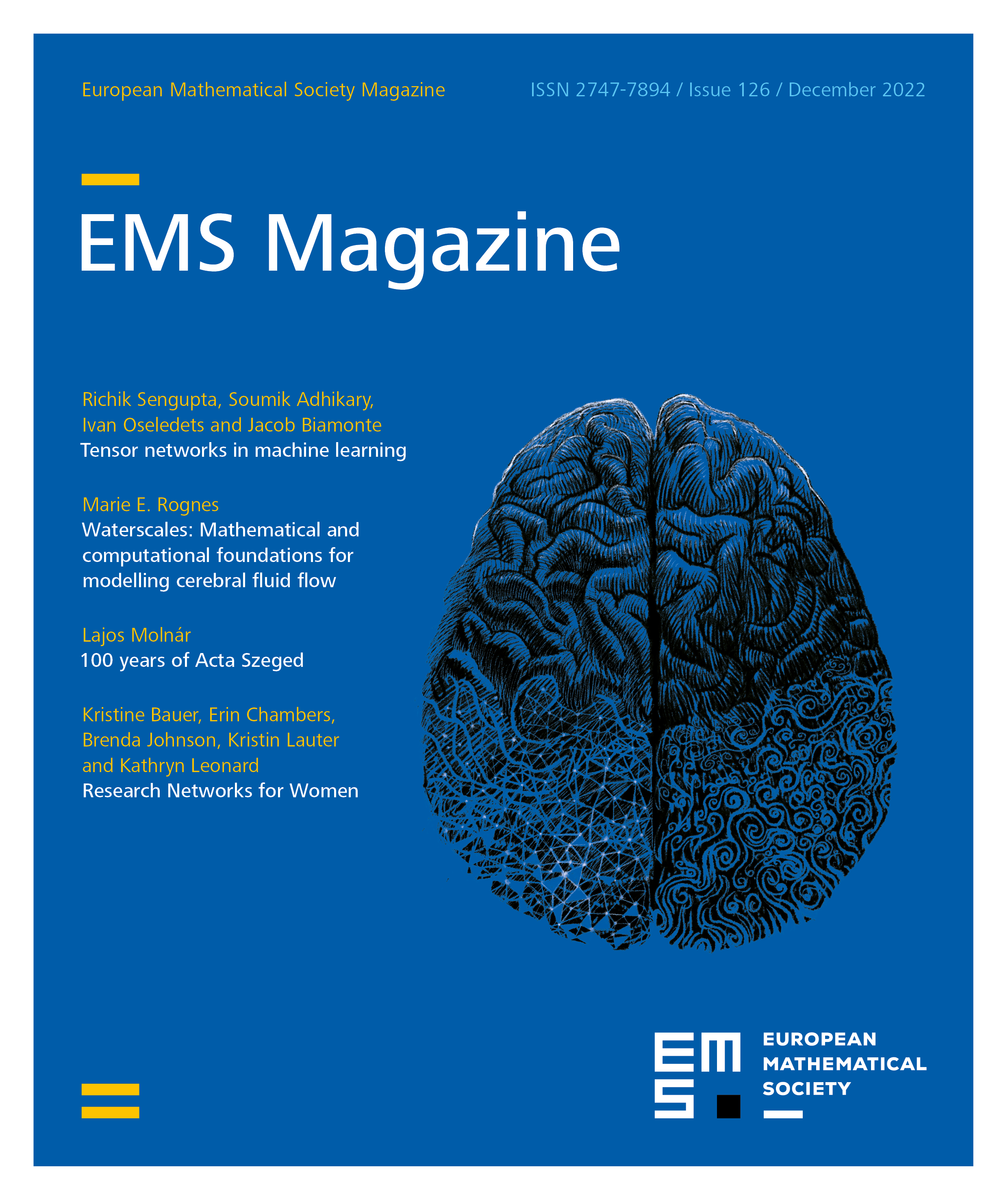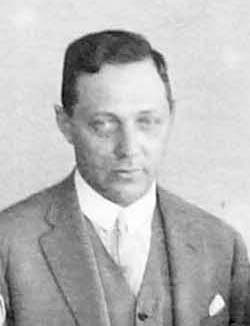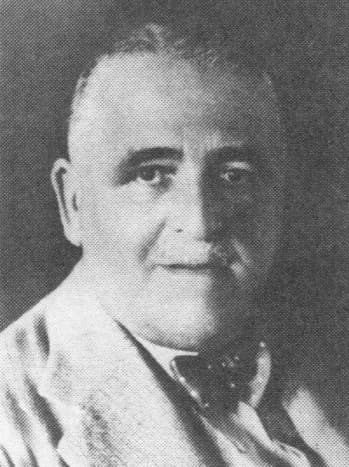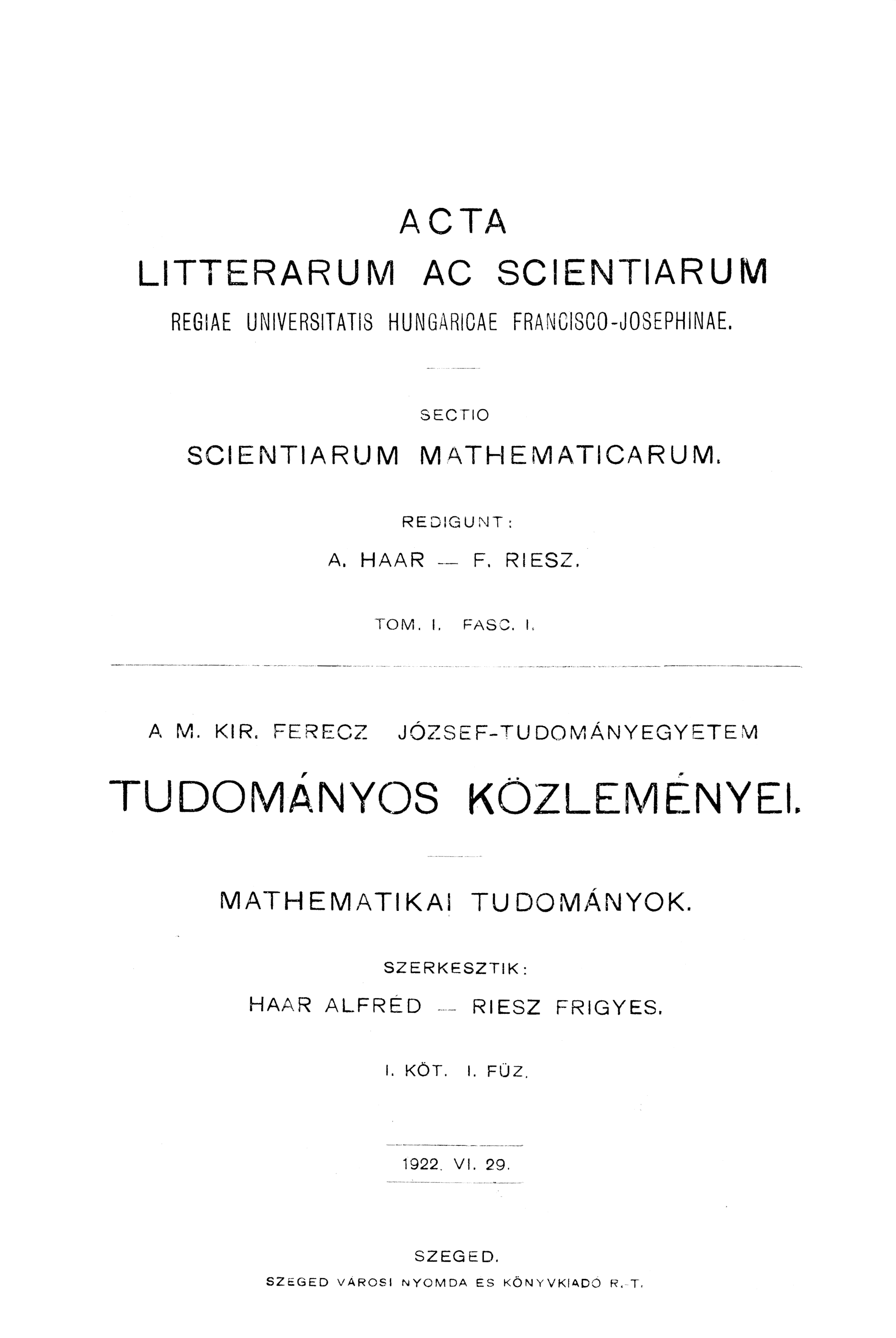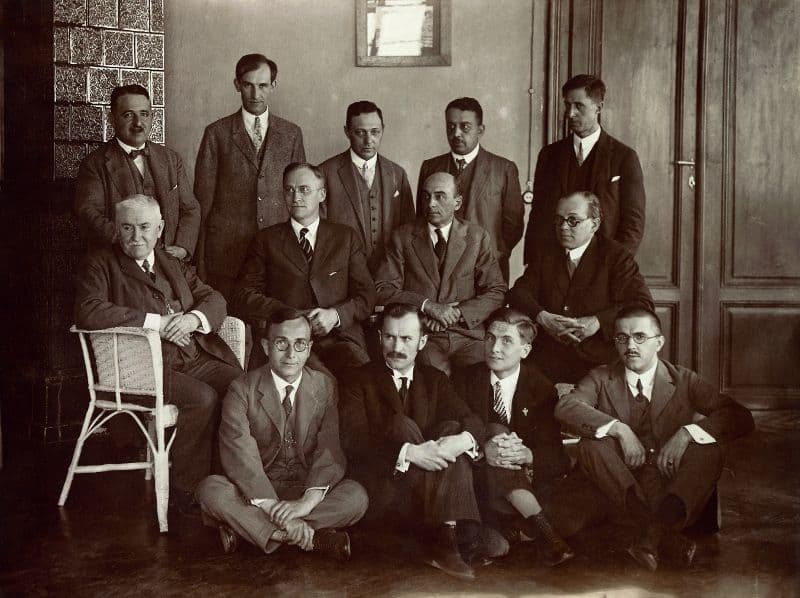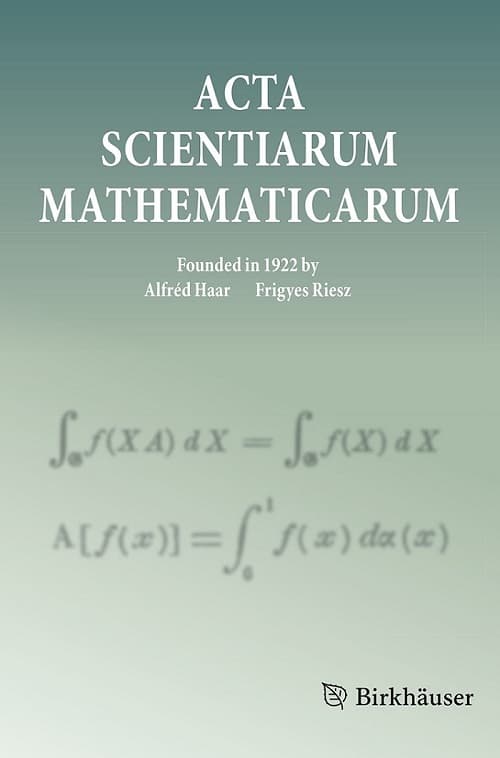1 Highlights from History
In the 1870s the idea of founding a third science university in the Hungarian Kingdom, besides the ones in Budapest and Kolozsvár (Cluj), was raised. The cities of Pozsony (Bratislava) and Szeged were strongly competing for hosting the new university. After the huge flood in 1879, which almost completely destroyed Szeged, the town was rebuilt from its ruins into a gorgeous city, and the public opinion, as well as a number of authorities, definitely supported the idea of the university. However, Pozsony, the former coronation city, won and the 3rd university was founded in 1912 there. Moreover, in the same year the 4th university was established in Debrecen.
So Szeged lost the fight for a university, but history soon changed the situation. After WWI, the Trianon Treaty of 1920 redefined Hungary’s map and Kolozsvár became a part of Romania. The faculty of the university was unwilling to take an oath to the Romanian king, so the university had to move. Kuno Klebelsberg, Minister of Religion and Public Education at that time, urged the transition of the university from Kolozsvár to Szeged which had became a border town in post-war Hungary. The plan was carried out, and in 1921 the university of Kolozsvár moved to Szeged.
Alfréd Haar and Frigyes Riesz, at that time already world-famous scholars and professors of the university in Kolozsvár, also settled in Szeged and founded a mathematical school.
All rights reserved.
In order to create the conditions for high-quality research in their new place of work they wanted to build an adequate mathematical library, as the library in Kolozsvár had to be left behind. Besides using the available (limited) financial sources and occasional donations, among them a generous one by the Rockefeller Foundation, they decided to establish and run a respected mathematical journal that could be used in exchange for other periodicals. This way they would create a stable and firm background for the library, so in 1922 they founded the journal commonly called Acta Szeged1Since its foundation the name of the journal was changed several times. First, it was Acta Literarum ac Scientiarum Regiae Universitatis Hungariae Francisco Josephinae, Sectio Scientiarum Mathematicarum; later it changed to Acta Universitatis Szegediensis, Sectio Scientiarum Mathematicarum; after WWII to Acta Scientiarum Mathematicarum (Szeged); and then it changed to Acta Universitatis Szegediensis, Acta Scientiarum Mathematicarum., and their plan for exchanges turned out to work with high efficiency.
The cover page of the first issue
©All rights reserved.
There exist documents concerning the initiations of those exchanges. We quote the following from [3 L. Rodríguez, Frigyes Riesz between the two world wars. BSHM Bull. 32, 235–245 (2017) ].
On 12 December 1922 Riesz wrote to Maurice Fréchet and sent him the first facsimile of Acta Szeged asking him to promote it (Riesz 1922). Fréchet’s reply came soon. On 16 December 1922 Fréchet answered that “it would be a honour” to receive Acta Szeged and he offered Riesz in exchange the Publications de l’Institut de Mathematiques de l’Université de Strasbourg as well as copies of doctoral dissertations that have been presented in the Mathematical Institute of the University of Strasbourg. … In 1922, G. H. Hardy wrote to Riesz discussing the exchange of Acta Szeged (Hardy 1922). There exist also three letters by Gösta Mittag-Leffler (Sweden) on the same topic from between 1923 and 1924 (Mittag-Leffler 1923, 1924).
The success of those early contacts was certainly due to Riesz’s high scientific stature in the international mathematical community. Apparently, Haar and Riesz did not want to rely on this exclusively, but they wanted to make the journal itself attractive, hence they invited several leading mathematicians to submit some of their works to Acta Szeged. These attempts were very successful. On the list of authors in the first years, we find, among others, the names of mathematicians such as John von Neumann, Norbert Wiener, George D. Birkhoff, Henri Cartan, Antoni Zygmund, Lipót Fejér, György Pólya, Gábor Szegő. This fact contributed essentially to the achievement which E. R. Lorch described in his entertaining paper [2 E. R. Lorch, Szeged in 1934. Amer. Math. Monthly 100, 219–230 (1993) ] as follows:
Within a few years the Szeged Acta had a world-wide reputation. Every serious mathematics library receives it. So, Szeged is now known all over the world – at least to mathematicians.
In accordance with that description, Gyula Staar, a Hungarian scientific journalist, wrote in the collection [5 P. Weibel, Beyond art: A third culture: A comparative study in cultures art and science in 20th century Austria and Hungary. Springer, https://doi.org/10.1007/3-211-37846-4 (2005) ] that
Szeged soon became a research center in mathematics, and many people refer to this town even today as the “Hungarian Göttingen”.
We remark that already Kuno Klebelsberg preferred to describe Pécs, where the university in Pozsony moved after the Trianon Treaty, as the “Hungarian Heidelberg” and Szeged as the “Hungarian Göttingen”.
We quote an interesting story from [1 R. Hersh and V. John-Steiner, A visit to Hungarian mathematics. Math. Intelligencer 15, 13–26 (1993) ] demonstrating how demanding Riesz was concerning the quality of the papers to be published in their journal.
An anecdote about the Riesz brothers is told by both Szőkefalvi-Nagy and John Horvath. (Horvath was a long-time friend and colleague of Marcel Riesz.) It seems that Marcel once submitted a paper to the Szeged Acta, where Frigyes was founder and editor. It was certainly a good paper, but Frigyes wrote to his brother, “Marcel, you have written also better things.” To be fair, Marcel did publish in the Szeged Acta.
Indeed, in the first two volumes of the journal he published four papers.
The exchange of Acta Szeged was a real success and, by the thirties the library of the mathematical institute had the most extensive collection of mathematical journals in Hungary, both in variety and quality. It should be pointed out that from the 1930s Acta Szeged not only initiated such exchanges, but it also received a number of similar inquiries and offers. A document shows that in the period 1948–1965 there were 178 exchanges. We mention the names of 10 journals from the long list: Acta Math., Amer. J. Math., Ann. Math., Canad J. Math., Duke J. Math., J. London Math. Soc., Math. Ann., Proc. Cambridge Math. Soc., Proc. London Math. Soc., Trans. Amer. Math. Soc.
In addition to the journal exchanges, several publishers sent books to Acta Szeged for review which, as a compensation for the review in the journal, became the library’s possession.
Alfréd Haar passed away in 1933 and Frigyes Riesz moved to Budapest in 1946. From 1946 to 1981 Béla Szőkefalvi-Nagy (his surname is commonly shortened as Sz.-Nagy), a leading scholar in operator theory, was the editor-in-chief of the journal. He carried on the traditions that Haar and Riesz established, and handled the journal’s affairs with very particular care and devotion. His daughter Erzsébet (Sz.-Nagy and his wife raised six children) told that in the family they referred to Acta Szeged as Sz.-Nagy’s seventh child. During his long period of 35 years as editor-in-chief, Acta Szeged continued to be a highly respected periodical, it became an internationally leading journal in the fields of functional analysis and operator theory.
Besides Sz.-Nagy himself, who published 65 papers in the journal, many other outstanding researchers in these areas published high-impact works in Acta Szeged. We mention here T. Ando, H. Bercovici, A. Connes, Ch. Davis, J. Dieudonné, J. Dixmier, R. Douglas, N. Dunford, C. Foias, I. Gohberg, P. Halmos, W. Helton, M. G. Krein, H. Langer, M. A. Naimark, H. Radjavi, D. Sarason, D. Voiculescu, and the list could be continued much further.
After Sz.-Nagy’s time at the helm, the next editors-in-chief were László Leindler (in the period 1982–1992) and László Kérchy (in the period 1993–2017).
In 1999, one year after Sz.-Nagy passed away, his daughter Erzsébet established the Béla Szőkefalvi-Nagy Medal in memory of her father. This prize is to recognize distinguished mathematicians who published significant works in Acta Szeged.2The list of former recipients of the medal can be found at https://en.wikipedia.org/wiki/Béla_Szőkefalvi-Nagy#Award_in_his_honour
2 Some high-impact papers from Acta Szeged
It should come as no surprise that the journal has published several important high-impact papers during its history. In this section, we present a dozen of them.
We start with a work by John von Neumann which appeared in the first volume.
J. von Neumann, Zur Einführung der transfiniten Zahlen. Acta Sci. Math. (Szeged)1, 199–208 (1922–23)
Ordinals as transfinite variants of non-negative integers were used from the very beginning of set theory, but they were external objects, which was not a convenient feature.
The basic requirement concerning ordinals is that every well-ordered set should be associated with an ordinal and exactly the isomorphic well-ordered sets should have the same associated ordinal.
In the above paper, John von Neumann, at the age of 19, introduced the modern concept of ordinals which is used even today. He called a set an ordinal if is transitive (i.e., every element of is also a subset of ) and the relation is a well-ordering on . An ordinal is said to be less than if ; this defines a well-ordering on the collection of ordinals such that every ordinal is the set of all ordinals less than the one in question. Moreover, von Neumann also defined cardinals as ordinals with the property that whenever is an ordinal less that , then there is no surjective map from onto .
In this simple way, the complete theory of ordinals and cardinals can be built up.
From set theory, we move to the area of algebra and mention two papers.
M. Krasner and L. Kaloujnine, Produit complet des groupes de permutations et problème d’extension de groupes. III. Acta Sci. Math. (Szeged)14, 69–82 (1951)
In this paper, the authors introduced the concept of wreath product of groups and proved the following fundamental property. If is an extension of the group by the group , meaning that is a group having a normal subgroup that is isomorphic to and the factor group is isomorphic to , then the wreath product of and contains an isomorphic copy of . This result is referred to as Krasner–Kaluzhnin or Kaluzhnin–Krasner theorem.
After its introduction, many group theorists applied the wreath product to construct various counterexamples and to prove embedding theorems. The wreath product became one of the main tools of group theory.
The other algebra paper concerns lattice theory.
G. Grätzer and E. T. Schmidt, Characterizations of congruence lattices of abstract algebras. Acta Sci. Math. (Szeged)24, 34–59 (1963)
This paper contains the so-called Grätzer–Schmidt theorem which says that the algebraic lattices (i.e., complete, compactly generated lattices) are exactly those that are isomorphic to the lattices of all congruence relations of abstract algebras. This solves a problem raised by G. Birkhoff in 1948 and became a fundamental theorem in universal algebra.
We proceed with a paper from geometry.
Á. Császár, A polyhedron without diagonals. Acta Univ. Szeged. Sect. Sci. Math.13 140–142 (1949)
This paper was inspired by the following incorrectly posed problem in a mathematical competition for students in Hungary in 1948: Prove that there is no polyhedron, beyond the tetrahedron, where any two vertices are connected by an edge. In other words, the assertion was that the tetrahedron is the only polyhedron without diagonals.
Indeed, this statement is valid for convex polyhedra. However, in this paper, Császár gave a nonconvex example that has no diagonal. Interestingly, the paper did not inspire many further studies until Martin Gardner’s popular paper “Mathematical Games: On the remarkable Császár polyhedron and its applications in problem solving” which appeared in Scientific American in 1975. Currently, Google search displays thousands of hits to the expression “Császár polyhedron”.
We now move to the area of analysis, namely potential theory.
O. D. Kellogg, Some notes on the notion of capacity in potential theory. Acta Sci. Math. (Szeged)4, 1–5 (1928–29)
This short paper contains three fundamental theorems in potential theory. The first one is the so-called generalized maximum principle for harmonic functions. The standard maximum principle says that if a (bounded) harmonic function is non-negative on the boundary of a domain , then the same is true on the whole domain. Kellogg’s observation is that for lower bounded functions non-negativity is not needed to hold at each point of the boundary, there can be a set of exceptional points which is of zero capacity.
For the second result, let be a domain and let be a closed set. The problem of removable singularities for harmonic functions reads as follows: For which is it true that any bounded harmonic function on admits a harmonic extension to the whole domain ? In this paper, Kellogg proved that this is true exactly when has zero capacity.
The third result says that if is a domain and is a subset of its boundary having positive capacity, then necessarily contains a so-called regular point ; i.e., a point with the property that if the function in the boundary condition for the Dirichlet problem is continuous at , then the Dirichlet solution is also continuous at . In other words, the set of irregular points always has zero capacity.
We insert here a photo, one of the most precious relics of the mathematical institute in Szeged, which was taken during the visit of G. D. Birkhoff and O. D. Kellogg to Szeged in 1928.
Upper row: F. Riesz, B. Kerékjártó, A. Haar, D. Kőnig, R. OrtvayMiddle row: J. Kürschák, G. D. Birkhoff, O. D. Kellogg, L. FejérLower row: T. Radó, I. Lipka, L. Kalmár, P. Szász
©All rights reserved.
The next paper we mention here is an important work by F. Riesz from the first issue of the journal.
F. Riesz, Sur les valeurs moyennes du module des fonctions harmoniques et des fonctions analytiques. Acta Sci. Math. (Szeged)1, 27–32 (1922–23)
Here Riesz introduced the concept of subharmonic functions and verified some of their fundamental properties. The definition itself is simple: A real-valued continuous function defined on a domain is called subharmonic if for any point in and for any closed disc centered at which is contained in , the value is less than or equal to the integral mean of along the boundary circle of the disc. Subharmonic functions are now central objects in modern potential theory.
Next, we list two papers from the area of measure theory/probability.
A. Prékopa, Logarithmic concave measures with application to stochastic programming. Acta Sci. Math. (Szeged)32, 301–316 (1971)
A. Prékopa, On logarithmic concave measures and functions. Acta Sci. Math. (Szeged)34, 335–343 (1973)
Currently, the latter one is the most cited paper that appeared in Acta Szeged – it has 162 citations in MathSciNet and 732 citations in Google Scholar. The former paper is also highly cited: 104 citations in MathSciNet, 552 citations in Google Scholar.
The author, A. Prékopa is one of the initiators of the field called stochastic programming. Some of his main results in that field concern the convexity theory of probabilistic constrained stochastic programming problems; i.e., the question of the convexity of the feasible sets of solutions of such problems). These two papers provide the most fundamental results of this theory. In them he introduced the concept of logarithmic concave measures and proved the following.
If a Borel measure on originates from a logconcave function (density), then the measure is logconcave, i.e., its satisfies the inequality for all Borel sets and any real number .
If we integrate a multivariate logconcave function with respect to some of its variables over their entire space, then the resulting function of the other variables remains logconcave.
These are breakthrough results that establish the convexity of the feasible set of solutions for a wide class of probabilistic constrained stochastic programming problems. Besides those consequences, the results found applications in convex geometry, mathematical analysis, and in some areas of physics, statistics, and economics.
Finally, we move to operator theory, the main focus of the journal during the period of B. Sz.-Nagy. We begin with some of his papers.
B. Sz.-Nagy, On uniformly bounded linear transformations in Hilbert space. Acta Univ. Szeged. Sect. Sci. Math.11, 152–157 (1947)
This is Sz.-Nagy’s most cited paper, it has 88 citations in MathSciNet and 263 citations in Google Scholar.
The main result in the paper is the following fundamental theorem. An invertible bounded operator on a Hilbert space is similar to a unitary operator if and only if the set of all integer powers of forms a uniformly bounded family; i.e., it is a bounded set in the operator norm.
B. Sz.-Nagy, Sur les contractions de l’espace de Hilbert. Acta Sci. Math. (Szeged)15, 87–92 (1953)
This is the first part of a series of 12 papers on contractions, which are bounded operators with norm not greater than 1. The research was motivated by the aim to better understand the fine structure of general linear operators on Hilbert spaces (observe that any bounded linear operator is a scalar multiple of a contraction).
In this paper it is proved that to any contraction on a Hilbert space one can associate a larger Hilbert space and a unitary operator on such that for any non-negative integer , the th power of equals the th power of multiplied from the left by the orthogonal projection of onto : (we also have ). This property is described by saying that every contraction admits a unitary power dilation. It is a fundamental result which says that we can reproduce (in some sense) general operators from two particular and well-understood types of operators: unitaries and orthogonal projections.
As mentioned above, this work was followed by 11 other papers with the same title, numbered from II to XII, which constitute the base of the following famous book in which the authors created a new important branch of operator theory. The papers from number III on were joint works with C. Foias, a young Romanian colleague of Sz.-Nagy.
B. Sz.-Nagy and C. Foias, Analyse harmonique des opérateurs de l’espace de Hilbert. Masson et Cie, Paris; Akadémiai Kiadó, Budapest (1967)
The book was translated into Russian and English. We quote from the foreword to the Russian translation written by M. G. Krein (see [4 B. Sz.-Nagy, C. Foias, H. Bercovici and L. Kérchy, Harmonic analysis of operators on Hilbert space. 2nd ed., Universitext, Springer, New York (2010) ]):
In 1953, the famous Hungarian mathematician B. Szőkefalvi-Nagy published in the journal Acta Scientiarum Mathematicarum (Szeged) a theorem, now widely known, on the unitary dilation of contractions. This work was soon continued by the author and other researchers. In 1958, the young Romanian mathematician C. Foias joined in the elaboration of the theory of contractions. Since then a series of articles by B. Sz.-Nagy and C. Foias, under the common title On the Contractions of Hilbert Space, has appeared regularly in Acta Szeged. This research has evolved into a well-developed theory, which plays an important role in modern functional analysis.
Next, we refer to the following important paper by T. Ando which is closely related to the mentioned dilation theorem by Sz.-Nagy.
T. Ando, On a pair of commutative contractions. Acta Sci. Math. (Szeged)24, 88–90 (1963)
According to MathSciNet, with its 136 citations, this is the most cited paper in operator theory published in Acta Szeged. Google Scholar displays 414 citations.
Ando proved in this paper that any two commuting contractions on a given Hilbert space admit commuting unitary power dilations. This answers a question raised by Sz.-Nagy. For curiosity, we mention that a similar result does not hold for triples of commuting contraction, as proved by S. Parrott in 1970.
We close our list with the following paper.
N. Dunford, Resolutions of the identity for commutative -algebras of operators. Acta Sci. Math. (Szeged)12, 51–56 (1950)
In this work the author developed an approach to the spectral theorem of normal Hilbert space operators that was built on the Gelfand–Naimark theorem for commutative -algebras and on Kakutani’s generalization of the Riesz representation theorem concerning bounded linear functionals on spaces of continuous functions. By now this approach became the most standard one, the majority of monographs and textbooks on the topic follow it.
The above list is, naturally, incomplete.
3 The 100th anniversary
Acta Szeged celebrates the 100th anniversary of its foundation in 2022. Indeed, it is the first international mathematical journal published in Hungary and one of the 20 oldest and still active periodicals in mathematics worldwide. On the occasion of the anniversary, we have made several changes around Acta Szeged. First of all, we have extended the editorial board. In the first 100 years, the board consisted of local members only. This year several outstanding mathematicians from abroad have joined the board.3The webpage of the journal is https://www.springer.com/journal/44146 and the current list of the members of the editorial board is given at https://www.springer.com/journal/44146/editors
The publisher of the journal has also changed. From 2022, it is published by Springer Nature/Birkäuser (while the owner remains the Bolyai Institute of the University of Szeged).
The new cover page
©All rights reserved.
We have already pointed to the fact, from the period when Sz.-Nagy was the editor-in-chief, the main focus of the journal was on functional analysis and operator theory. This motivated us to publish a related special issue (the double issue 1–2 of volume 88) dedicated to the 100th anniversary. We invited renowned researchers from those areas who once published papers in Acta Szeged to submit current works of theirs. We received a number of valuable contributions and the quite thick special issue will come out soon.
Besides publishing a special issue, we also organized an online scientific meeting for researchers from those areas to celebrate the memorable event. The meeting took place on May 5–6, 2022 and over 200 people registered for it.4The talks at the meeting were recorded and are available on the YouTube channel of Springer: https://www.youtube.com/playlist?list=PLLe3TzudRmf3SgBAHRJy6nlA-YRfSmQTZ
4 Afterword
Having such a long and bright history of the journal, what can we say about the future? Very briefly: we try to keep walking in the steps of the great predecessors and, at the same time, address the challenges of modern times.
Although functional analysis and operator theory are focus areas of the journal, we follow the original tradition and consider Acta Szeged a broad-in-scope mathematics journal. High-quality submissions from other areas of analysis, algebra, and geometry are always very welcome.
The reorganized journal starts the next period with some fresh momentum and we will do our best to make it prosper further in the long run.
- 1
Since its foundation the name of the journal was changed several times. First, it was Acta Literarum ac Scientiarum Regiae Universitatis Hungariae Francisco Josephinae, Sectio Scientiarum Mathematicarum; later it changed to Acta Universitatis Szegediensis, Sectio Scientiarum Mathematicarum; after WWII to Acta Scientiarum Mathematicarum (Szeged); and then it changed to Acta Universitatis Szegediensis, Acta Scientiarum Mathematicarum.
- 2
The list of former recipients of the medal can be found at https://en.wikipedia.org/wiki/Béla_Szőkefalvi-Nagy#Award_in_his_honour
- 3
The webpage of the journal is https://www.springer.com/journal/44146 and the current list of the members of the editorial board is given at https://www.springer.com/journal/44146/editors
- 4
The talks at the meeting were recorded and are available on the YouTube channel of Springer: https://www.youtube.com/playlist?list=PLLe3TzudRmf3SgBAHRJy6nlA-YRfSmQTZ
References
- R. Hersh and V. John-Steiner, A visit to Hungarian mathematics. Math. Intelligencer 15, 13–26 (1993)
- E. R. Lorch, Szeged in 1934. Amer. Math. Monthly 100, 219–230 (1993)
- L. Rodríguez, Frigyes Riesz between the two world wars. BSHM Bull. 32, 235–245 (2017)
- B. Sz.-Nagy, C. Foias, H. Bercovici and L. Kérchy, Harmonic analysis of operators on Hilbert space. 2nd ed., Universitext, Springer, New York (2010)
- P. Weibel, Beyond art: A third culture: A comparative study in cultures art and science in 20th century Austria and Hungary. Springer, https://doi.org/10.1007/3-211-37846-4 (2005)
Cite this article
Lajos Molnár, 100 years of Acta Szeged. Eur. Math. Soc. Mag. 126 (2022), pp. 27–32
DOI 10.4171/MAG/113